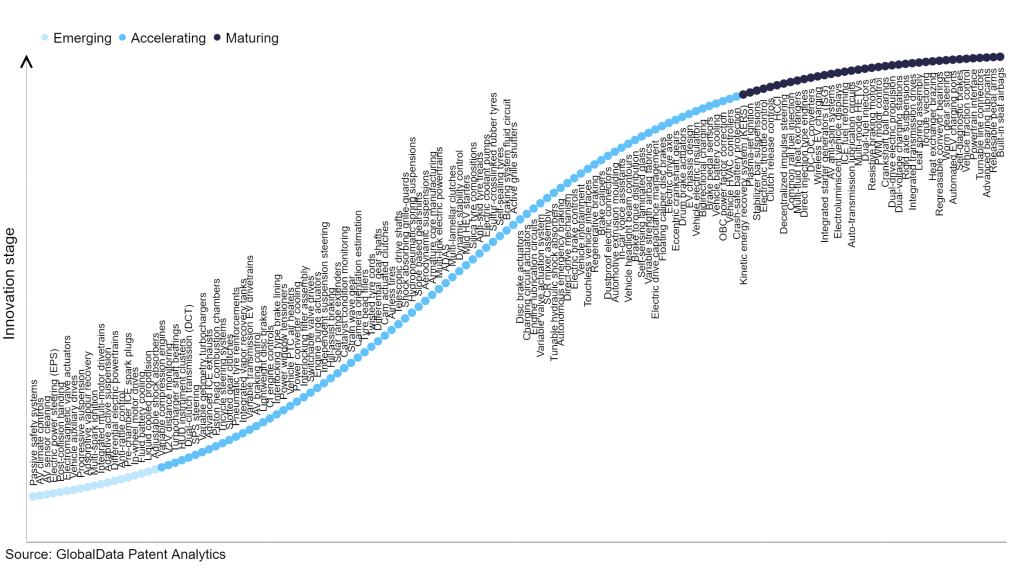The automotive industry continues to be a hotbed of patent innovation. Activity is driven by enhanced driving experience, fuel efficiency, and engine performance, and growing importance of technologies such as electromechanical actuators, electrification, and connected and autonomous vehicles. In the last three years alone, there have been over 1.7 million patents filed and granted in the automotive industry, according to GlobalData’s report on Innovation in automotive: piston head combustion chambers. Buy the report here.
However, not all innovations are equal, and nor do they follow a constant upward trend. Instead, their evolution takes the form of an S-shaped curve that reflects their typical lifecycle from early emergence to accelerating adoption, before finally stabilizing and reaching maturity.
Identifying where a particular innovation is on this journey, especially those that are in the emerging and accelerating stages, is essential for understanding their current level of adoption and the likely future trajectory and impact they will have.
300+ innovations will shape the automotive industry
According to GlobalData’s Technology Foresight, which plots the S-curve for the automotive industry using innovation intensity models built on over one million patents, there are 300+ innovation areas that will shape the future of the industry.
Within the emerging innovation stage, integrated multi-motor drivetrains, electric power steering (EPS), and post-collision handing are useful technologies that are in the early stages of wider application and should be tracked closely. Variable compression engines, V2V distance monitoring, and turbocharger shaft bearings are some of the accelerating innovation areas, where adoption has been steadily increasing. Among maturing innovation areas are kinetic energy recovery system (KERS) and plasma-jet ignition, which are now well-established in the industry.
Innovation S-curve for the automotive industry

Piston head combustion chambers is a key innovation area in automotive
Most combustion chambers in a diesel engine are formed in the piston crown. Engines use the squish effect to push the mixture at the chamber's edges in the direction of the moving flame in front. The speed at which the mixture is forced inwards is influenced by several variables, such as the size and shape of the squish, the engine stroke, and the engine speed. As the piston descends, the opposite occurs, and the enflamed volume is drawn out toward the chamber's edges.
GlobalData’s analysis also uncovers the companies at the forefront of each innovation area and assesses the potential reach and impact of their patenting activity across different applications and geographies. According to GlobalData, there are 20+ companies, spanning technology vendors, established automotive companies, and up-and-coming start-ups engaged in the development and application of piston head combustion chambers.
Key players in piston head combustion chambers – a disruptive innovation in the automotive industry
‘Application diversity’ measures the number of applications identified for each patent. It broadly splits companies into either ‘niche’ or ‘diversified’ innovators.
‘Geographic reach’ refers to the number of countries each patent is registered in. It reflects the breadth of geographic application intended, ranging from ‘global’ to ‘local’.
Patent volumes related to piston head combustion chambers
Source: GlobalData Patent Analytics
Mazda Motor is one of the leading patent filers in piston head combustion chambers. The company is focusing on the development of an innovative hybrid lightweight piston for marine engines, which aims to lower operating costs and emissions. Other companies innovating in this technology domain are Caterpillar, Tenneco, Porsche Automobil, and Toyota Motor.
In terms of application diversity, Denso held the top position, while Contour Hardening and IFP Energies nouvelles stood in second and third positions, respectively. By means of geographic reach, Tenneco leads the pack, followed by Volvo and Denso.
To further understand the key themes and technologies disrupting the automotive industry, access GlobalData’s latest thematic research report on Automotive.
Data Insights
From

The gold standard of business intelligence.
Blending expert knowledge with cutting-edge technology, GlobalData’s unrivalled proprietary data will enable you to decode what’s happening in your market. You can make better informed decisions and gain a future-proof advantage over your competitors.







